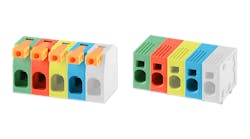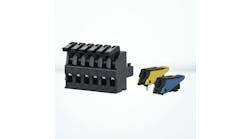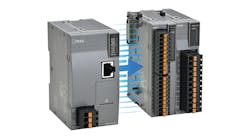When intangible software starts to alter physical hardware, we can begin to understand the breadth and depth of digitalization's impact on process controls, automation and pretty much everything else. For many years, software ran on increasingly powerful microprocessors and faster networks, but their basic infrastructure remained mostly the same. More recently, the demands and promised capabilities of data processing and the Internet are even stretching I/O, terminal blocks and other device-level components into new shapes to suit their needs.
Select, simplify and streamline
For instance, removing unhelpful and toxic elements at SemCAMS Wapiti sour gas plant in northern Alberta, Canada, requires specialized equipment and controls (Figure 1). Because cleaning H2S, propane, butane and other impurities is mission-critical for the facility and worrisome for its operators and manager, Wapiti recently got a much-needed boost from its recent upgrade with system integrator Blackrock Automation in Taber, Alberta, and ABB's newly released Select I/O with common template and System 800xA automation platform.
Figure 1: SemCAMS Wapiti worked with system integrator Blackrock Automation to implement new Select I/O with common template and System 800xA automation platform from ABB to help clean H2S, propane, butane and other impurities at its new sour gas plant in northern Alberta, Canada. Source: SemCAMS Wapiti and Blackrock
The facility processes about 200 million cubic feet of sour gas per day and was seeking one I/O solution and a standard, remote cabinet, which could enable hardware on-site sooner and keep pace with its aggressive schedule. The project included:
- 27 Select I/O remote cabinets for the plant's -40 °C and Class I, Div. 2 environment;
- System 800xA controls with 2,300 Select I/O and 300 S800 control-related I/O;
- 16 Allen-Bradley PLC packages connected by PLC Connect (OPC); and MCC communications with more than 40 Multilins and VFDs via Profinet.
"It was -42 °C when we started up, but there were no equipment problems, the whole project's mechanical and electrical systems worked well, and we came in two months early and under budget," says Galen Wilton, senior system integrator at Blackrock. "Startup took just two days to selling gas, and the client was so proud that they announced it on the local radio."
Robert Norberg, I/O systems global product manager, ABB, reports Select I/O was developed to meet the needs of users just like SemCAMS Wapiti. "Traditional, controller-centric I/O solutions promote an inflexible, serial, sequential project execution model in which project tasks depend on each other, resist changes, and cause change orders and delays," says Norberg. "The result of process automation being on the critical path is large cost overruns and late delivery on large capital projects.
"This is why System 800xA's flexible I/O, Select I/O and S800 on Ethernet, and xStream Engineering are so useful in these applications. They can minimize the impact of late changes, decouple project tasks so they can be done in parallel, and reduce testing efforts needed and required footprints."
This flexibility aided SemCAMS Wapiti's installation schedule and took much of the project off the stressful critical path.
Modularity enables IIoT
Beyond the advantages that more flexible I/O can provide, many suppliers and other observers report improved device-level connectivity and modularity can also help process applications access the Industrial Internet of Things (IIoT), cloud-computing services and other digitalization efforts.
"We're seeing increasing convergence between operations technology (OT) and information technology (IT), especially for IIoT and smart manufacturing. Many folks are moving in this direction to gain efficiencies, but still maintain cybersecurity," says Alan Sappé, product marketing manager for industrial cabinet connectivity, Phoenix Contact. "Along with the pressure to streamline, minimize and reduce components for systems when users access the cloud, analyze data and use cloud storage comes the need for more I/O, so these functions can get the information they need to digest."
Efforts to get more performance out of the same or new gear means I/O points, panels and architectures may look the same, but Sappé reports there's more forethought and intelligence going on behind the scenes. "Many users want to extend the reach of their Ethernet networks, but even though they're still using the same connections and hardware, more of these I/O and relays have microprocessors and added intelligence," explains Sappé. "This also means terminal blocks need more reliability, such as Phoenix Contact's PT push-in terminals for more reliable connections that also save time and space. In the 10 years since they were introduced, we've added PT connections to relays, I/O, surge protectors and power supplies. These standardized connections also optimize panel designs."
For example, E-Finity Distributed Generation LLC in Wayne, Pa., builds onsite, distributed power generation and combined heat and power (CHP) plants, and employs PT blocks, Mini Pro signal conditioners and other Phoenix Contact components. "Our customers have different sets of inputs based on their applications. To avoid having to customize our I/O modules on our controllers, we wanted to easily swap out a device in the controller, rather than the wiring involved in it, and the Mini M series allowed us to do it. The input wiring is all standardized for RT thermocouple or analog voltage input, and we can use programmable Mini MCRs with standard 4-20 mA out. These let us use standard I/O modules that are 4-20 mA on our I/O. This lets customers choose RTD thermocouple, voltage or analog inputs, and all we have to do is select the correct Mini MCR module." E-Finity also reports it's easy to remove and replace PT terminal blocks in the field, and use their push-in connections, as well as test ports to test the signals on the card.
Sappé adds that Phoenix Contact also recently released its PTFIX mini power distribution blocks with multiple connection points in a small form factor. "Users are comfortable with familiar technologies, but even though digitalization is unfamiliar, they should still try it because it can get them into smarter manufacturing," says Sappé. "We can even send samples of PT and other components, so they can try them and really kick the tires."
Connectivity, control chime in
Naturally, just as I/O are essential for digitalization, more efficient connections between them and related devices can help them all link up and get networked for success.
"We're seeing more quick disconnects impacting I/O systems, less use of terminal blocks, and more connectorized solutions for Class I, Div. 2 hazardous locations," says Chris Vitale, head of fieldbus technology at Turck. "Previously, everything was wire and conduit, but now there's more use of M12 and our Minifast connectors that thread in and out quickly. This has been going on for about 15 years, but we're still experiencing a lot of growth as modular equipment continues to expand in machines, skids and plants. Users also continue to lack in-house engineering, so they need cost-effective, connectorized products that less-experienced personnel can install or swap out."
Vitale reports users can also replace cabinets with I/O systems that already have built-in terminal blocks. "It's more effective to use I/O that's connectorized or has quick disconnects," adds Vitale. "I/O is getting to be better understood and accepted by mainstream users. This is because their IIoT and Industry 4.0 applications don't just indicate that a valve is on or off. These smart devices want trends from other data that can be transmitted."
For example, Vitale adds that the 14-year-old IO-Link protocol and its connectors and cables are point-to-point, but their masters and end devices can deliver large amounts of device-level data in conjunction with Ethernet. "Many engineers are trying to keep their processes going, and with IO-Link, they can replace one sensor and still use their old cable infrastructure, or upgrade just as easily," he says. "This is why it's been catching on in the past three years. IO-Link can deliver temperature, number of cycles, and other data engineers can use."
Likewise, the overall transition from serial to Ethernet networking inspired Turck and others to develop Ethernet I/O modules that could provide web servers; bypass legacy PLCs; still see what's happening in the field; and let users set up, maintain and troubleshoot their processes. "This is all leading to more intelligent I/O and other devices with onboard chips," says Vitale. "We changed our strategy on Ethernet a few years ago, and now it's the digitalization pipeline. We have devices that can talk to multiple protocols like Profinet, EtherNet/IP and Modbus, and also recently added a spanner module that can translate the protocols, and let PLCs and other devices communicate with each other."
Turck even has a Field Logic Controller located inside an I/O device, which networks via Ethernet and a web server interface to run logic programs. "We're not replacing any PLCs or DCSs. We're just picking up logic tasks that might overburden some PLCs or DCSs," adds Vitale. "Communications of all kinds are flattening, and we're learning to talk to almost any device in some way. Turck even launched a cloud service in Europe last year, and it will likely come to the U.S. soon to support devices, too."
Turck also recently launched its Backplane Ethernet Extension Protocol (BEEP), which is integrated into many of its multi-protocol digital block I/O modules. BEEP allows a network of as many as 33 devices (one master and 32 slaves) or 480 bytes of data to appear to the PLC as one device on one connection using one IP address. By reducing the number of connections the PLC sees, users can create high-density I/O networks and still use their low-cost PLC.
The BEEP web server makes the first device in the line a master, and it can then scan the entire network and create a new data map that includes all of the downstream devices, with all device configuration options saved in the master. BEEP also supports drop-in device replacement, reducing downtime and overall costs. If a network is set up using BEEP, a technician can simply replace a slave device with a new device to keep the system online. The BEEP master will automatically recognize the device, assign it an IP address, and download the parameters to it.
Off the critical path
It's fortunate faster I/O connections are available because the need for them is only likely to increase. Back at SemCAMS Wapiti in Alberta, Brad MacDonald, IAEN product marketing manager, ABB, reports, "When projects plan to execute, the date everyone usually wants to know is the design-freeze day. With Select I/O, they don't have to worry about it anymore. Now, they just build the cabinet, roughly determine how many I/O are needed, but don't have to care what type because Select I/O's common template can connect to so many different devices.
"In Blackrock's case, their design started with 1,200 I/O, but ended with 2,400 I/O because of added pipes and other devices. In the past, this would mean huge and costly change orders, but now they can simply order extra I/O as needed and expand to accommodate them. What's so cool about splitting design engineering off from cabinet assembly and installation is that it finally takes automation off the critical path."
Wilton reported that SemCAMS Wapiti's remote I/O cabinets were designed in Fall 2017, configured in February 2018, built in April-May 2018, and installed and wired in July-October 2018, which included client FAT of configuration in August-September 2018. I/O loop checks and commissioning were done in late 2018, and production began in January 2019. The control and network architecture at the plant includes two virtual servers, two servers working as historians, four operator stations, three engineering stations, links via PLC Connect to EtherNet/IP, and two PM891 controllers in two S800 cabinets networked with Modbus and Profibus for remote MCCs.
Figure 2: Operators can easily switch between day- and night-mode color schemes on HMI screens to improve operator effectiveness at SemCAMS Wapiti's new sour gas plant. The System 800xA control and network architecture from ABB includes four operator stations and three engineering stations that manage 27 remote I/O cabinets, each with six module terminal units and 96 I/O per cabinet. Source: SemCAMS Wapiti and Blackrock
"We installed 27 remote I/O cabinets, each with six module terminal units (MTU) and 96 I/O per cabinet," explained Wilton. "We also had fully redundant power and heaters to comply with our Class I, Div. 2 design. The virtual servers meant we could set up and test at Blackrock's office in Calgary, and staging there and running the whole project in simulation was a big help. We also liked using System 800xA because its combined software package for functions like PLCs and HMIs meant we didn't have to implement them separately." (Figure 2.)
Kyle Hyland, senior system integrator, Blackrock, adds that, "System 800xA can also show trends, and give users all the data they like to see. Plus, we can just drop in new software objects, and they'll quickly show trend data."
Wilton agrees that System 800xA was easy to learn with a little coaching from ABB. "It was especially nice to have software-based controllers that we could test, and they're also allowing us to make adjustments, add features and even use them for training," says Wilton. "As a result, we were also able to field test all the cabinets in just two or three hours. Select I/O also saved a lot on cable by allowing us to use more flexible switching devices between panels and reassign them as needed. As a result, most changes were no longer about asking for money, but were about new ways to save money."
MacDonald adds, "Select I/O and System 800xA can save users 30-40% on the cost of projects by eliminating much of the engineering and cabling that was previously required."







